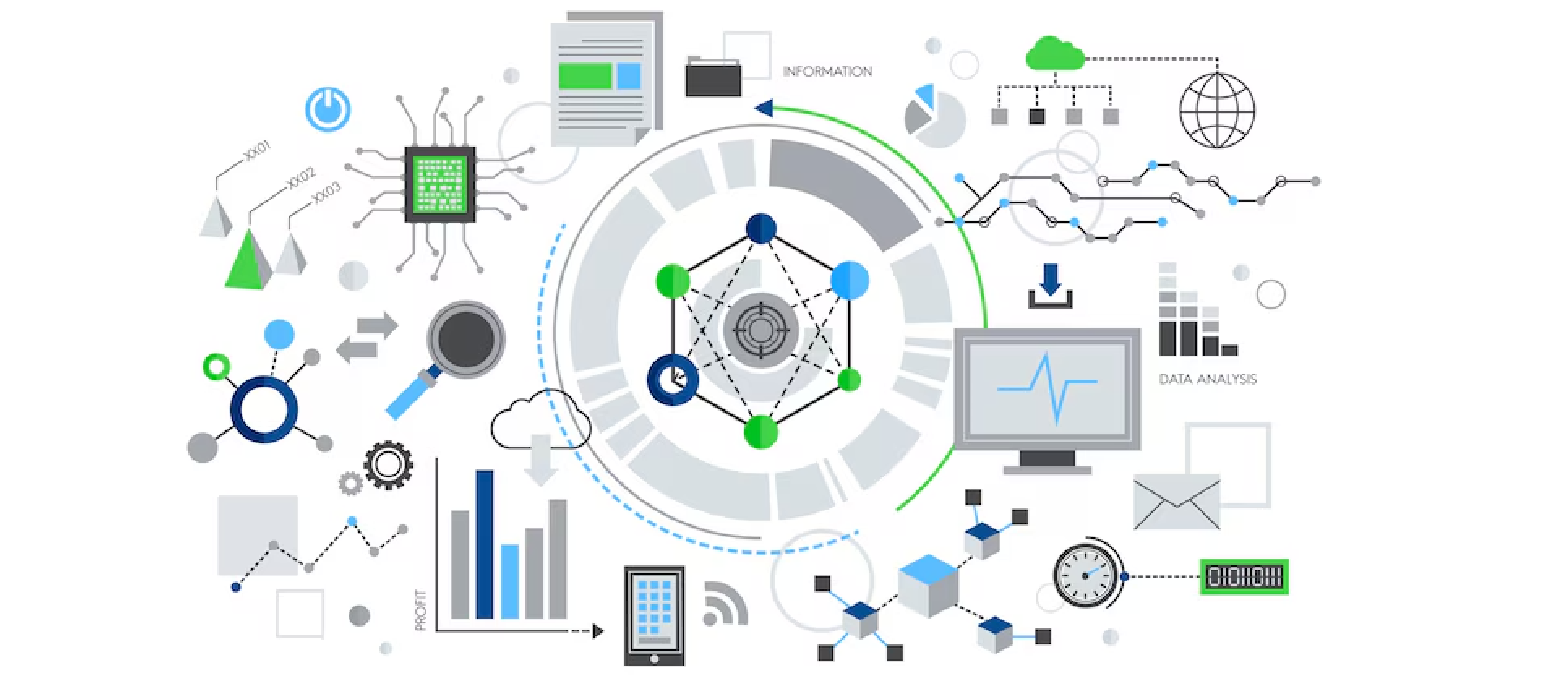AI in Data Analytics: AI is quickly becoming part of different applications. But what is the contribution of AI in the data analysis process? Data analytics involves the process of analyzing datasets to make conclusions about the information they hold. Data analytics has, over the last few decades, become a crucial aspect of decision-making by companies, governments, and institutions around the world.
Now, in this modern era, we have such enormous amounts of data being created in a second. Be it e-commerce purchases or sensor readings from IoT equipment, the demand for quality data analysis has never been so high. AI in data analytics, at its core, is the application of AI to analyze enormous datasets.
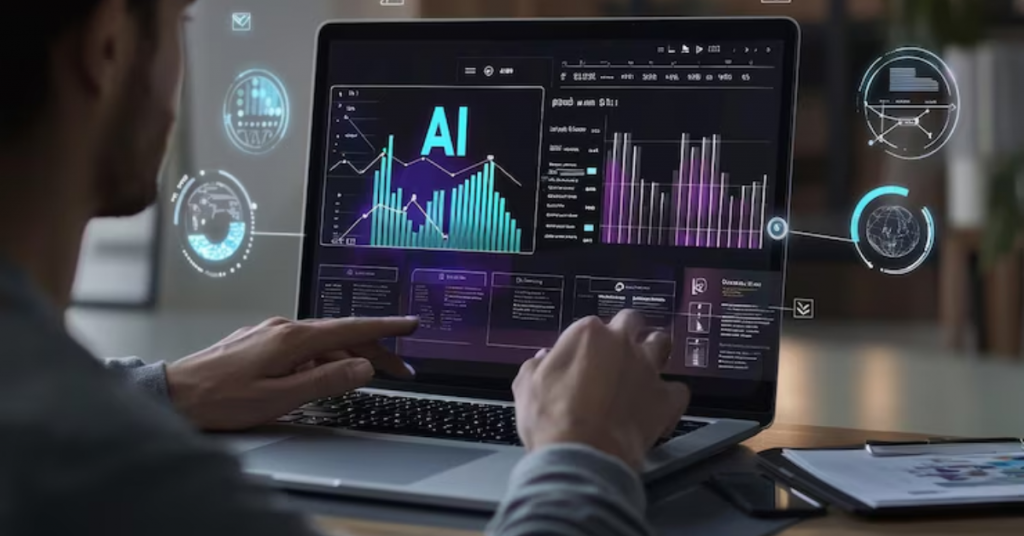
This helps data scientists and analysts determine trends and gain insight into consumer behavior or other data. AI-powered data analysis can help make sense of massive volumes of data quickly and efficiently by using powerful machine learning algorithms.
While businesses and organizations struggle to deal with more complex data, Artificial Intelligence (AI) has become an innovative answer to data analytics worldwide. AI provides sophisticated functionalities that are beyond the capabilities of conventional analytics tools, ranging from predictive analytics to auto-decision making, to amplify the overall efficiency of data-driven strategies.
Approximately 79% of companies report that AI adoption in marketing and sales has increased business revenue, with AI-based strategies contributing to at least a 20% increase in EBIT.
This blog takes you through all you should know about applying Artificial Intelligence in Data Analytics—how to use AI in analytics, advantages, disadvantages, and best practices for getting the best out of it for your organization.
Key Takeaways
- Data Analytics with AI is becoming essential, providing advanced capabilities for better data ingestion, analysis, and interpretation.
- Key technologies involved include machine learning (ML), natural language processing (NLP), and deep learning.
- AI enables smarter, more accurate predictive analytics and decision-making processes.
- While AI brings significant advantages, challenges such as data bias, privacy issues, and the lack of transparency remain.
Understanding how to implement AI in data analytics requires clear objectives, the right tools, and constant model evaluation.
Table of Contents
What is AI in Data Analytics?
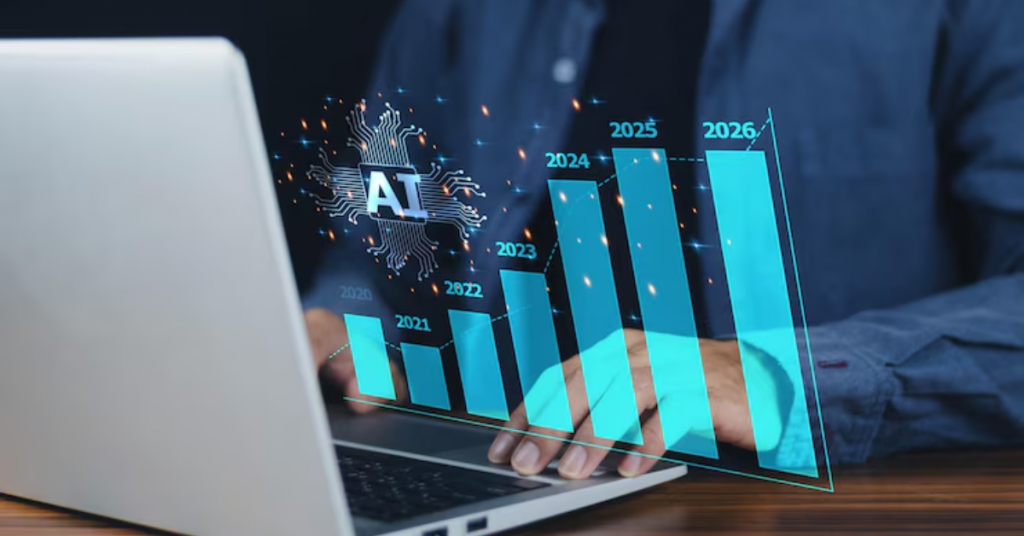
When it comes to evaluating vast volumes of data, artificial intelligence is essential. Artificial intelligence is a subfield of computer science. There are subcategories of AI tools used to help gather, clean, prepare, analyze, and interpret extracted data under the larger category of AI.
Machine Learning (ML), Natural Language Processing (NLP), deep learning, robotics, and image and speech recognition are AI subcategories that are utilized in data analysis processes or steps to provide insights to data analysts or decision-makers.
Without Artificial Intelligence in data analytics, firms would struggle to extract data from many sources, compile it, and present it in a legible style that a person could readily analyze to make an informed decision.
Differences Between Traditional and AI-Powered Analytics
In this section we will take a look at the key differences between Traditional and AI-powered data analysis:
| Aspect | Traditional Analytics | AI-Powered Analytics |
| Approach | Manual, rule-based | Automated, learning-based |
| Speed | Slower, batch processing | Real-time or near real-time |
| Scalability | Limited by human effort | Highly scalable |
| Pattern Detection | Predefined trends only | Finds hidden patterns automatically |
| Data Handling | Mostly structured data | All data types (structured, unstructured, etc.) |
| Insight Type | Descriptive | Predictive & prescriptive |
| Adaptability | Static, needs manual updates | Self-learning, continuously improves |
Types of AI Technologies Used in Analytics
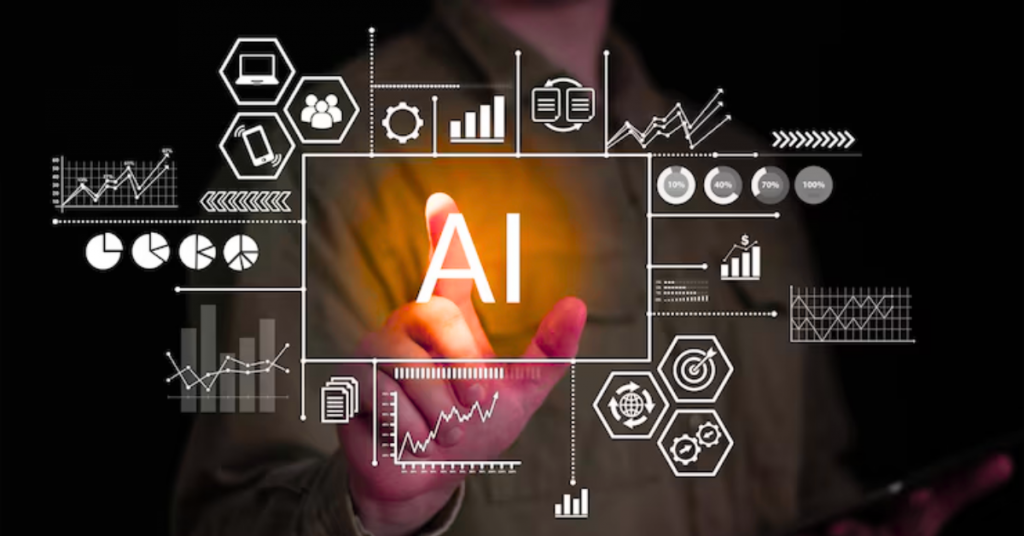
Artificial Intelligence in data analytics are required because they speed up the collecting and preparation process, discover patterns in data more efficiently than people, and spot anomalies in data better than any combined traditional strategy including humans examining data sets manually. It is unrealistic to rely on a human to process large amounts of data fast and accurately.
Several AI technologies play crucial roles in enhancing data analytics. The primary ones include:
- Machine Learning (ML): This allows systems to learn from data and improve predictions without explicit programming. ML models analyze historical data to predict future trends or classify data.
- Natural Language Processing (NLP): NLP enables systems to understand and process human language, making it possible to analyze unstructured text data from sources like emails, social media, and customer feedback.
- Deep Learning: A subset of ML, deep learning utilizes neural networks to process large amounts of data, such as images and speech, with unprecedented accuracy.
- Robotic Process Automation (RPA): In the context of analytics, RPA automates repetitive tasks like data entry and report generation, allowing analysts to focus on higher-level decision-making.

Practical Applications of AI in Data Analytics
AI in Data Analytics and tactics to assist firms in making better decisions based on data processed through data analytics. The role of AI in data analysis is especially evident in three key areas: data ingestion and preparation, advanced analytical capabilities, and output and visualization.
a. Data Ingestion & Preparation
Before any analysis can take place, data needs to be gathered, cleaned, and formatted. This process is time-consuming and prone to human error. AI-powered data analysis simplifies this by automating data ingestion and preparation, including the detection of missing values, the correction of inconsistencies, and the elimination of outliers. With machine learning, AI can even detect patterns within raw data, speeding up the process and ensuring that the data is ready for analysis faster.
b. Advanced Analytical Capabilities
AI-powered data analysis introduces a level of sophistication in analytics that traditional methods cannot achieve. For example, machine learning algorithms can perform advanced statistical analysis, uncovering hidden correlations within vast datasets. Predictive analytics, powered by AI, enables businesses to forecast future trends, market behaviors, or customer preferences with greater accuracy.
c. Output & Visualization
AI-powered tools also enhance data visualization. Rather than relying on static graphs and charts, AI can provide dynamic, interactive visualizations that help analysts uncover deeper insights. For example, AI algorithms can highlight outliers, trends, and anomalies in real-time, providing a more intuitive way for stakeholders to interpret complex data.
Benefits of Using AI in Data Analytics
The appeal and benefits of combining data analytics with AI are that managers and analysts no longer have to guess or estimate when making decisions. Instead, managers and analysts can make better judgments based on processed and analyzed data, resulting in data-driven decisions.
The four most common forms of data analytics are descriptive, diagnostic, predictive, and prescriptive analysis. Each analysis type is designed to address a single question.
> Enhanced Descriptive Analytics
AI enhances descriptive analytics by making it easier to understand past events and trends through automated data analysis. AI can quickly process large datasets to summarize patterns, trends, and anomalies, which otherwise would require extensive manual work.
Descriptive analysis focuses on what occurred. This analysis uses measurements of central tendency and dispersion, such as histograms, scatter plots, data mining, and reporting, to determine what occurred.
> Improved Diagnostic Analysis
AI can help businesses identify the root causes of problems by analyzing patterns in historical data. For example, AI can be used to examine the reasons behind customer churn, operational bottlenecks, or inventory issues. By automatically diagnosing issues, businesses can implement corrective actions more swiftly.
Diagnostic analysis seeks to understand why an event occurred. The diagnostic analysis starts with a root cause analysis, which describes the problem, gathers extensive information, such as the five Ws (who, what, when, where, and why), then brainstorms the most likely cause. The What-if analysis is also utilized, with the goal of changing variables to determine the conditions that are most likely to explain why an event happened. Correlation analysis, data mining, and drill-down analysis are approaches and strategies for determining why an event occurs.
> Accurate Predictive Forecasting
Predictive analytics powered by AI can provide businesses with highly accurate forecasts. Machine learning models, for instance, are capable of predicting customer behavior, market trends, and future demand by analyzing historical data and identifying patterns that humans may not notice. These predictions can be used for proactive decision-making, minimizing risks and maximizing opportunities.
This Data Analytics with AI focuses on future occurrences and employs simulation, regression, and forecasting approaches to determine what will happen. Machine learning, artificial intelligence, statistical models, and data mining are all used in predictive analysis to forecast the possibility of a future event.
> Smart Prescriptive Recommendations
AI doesn’t just stop at prediction; it can also offer prescriptive recommendations. By analyzing vast amounts of historical and real-time data, AI systems can suggest the best courses of action. For example, AI can help a retailer recommend products to customers based on past purchases or provide a manufacturing plant with real-time optimization suggestions to improve efficiency.
The most advanced analysis is prescriptive analysis, which aims to attain a specified future outcome by taking specific actions in the present. Prescriptive analysis makes use of modern algorithms, data mining techniques, machine learning, heuristics, and statistical methodologies to assist businesses identify what they need to do today to achieve a desired outcome in the future. Prescriptive analysis employs extensive modeling as well as descriptive and predictive studies to assist management in making the best decisions in the present that will most likely influence the future outcome desired by the organization.

Risks and Challenges of AI in Data Analytics
Bias in examined data is equally harmful as faulty data used to make business decisions. As a result, when training an AI system, the data analyst must guarantee that the data is unbiased and accurately reflects the actual status of the organization. Businesses that utilize data analytics must ensure that their data analysts are properly trained to avoid utilizing biased data to make business decisions. Bias data can be difficult to identify, making it a danger that must be avoided.
While Artificial Intelligence in Data Analytics offers significant advantages, it also presents a number of challenges and risks that businesses need to address:
> Data Manipulation and Bias Risks
AI models are only as good as the data they are trained on. If the data contains biases—whether in terms of gender, race, or socioeconomic status—the AI model can perpetuate or even amplify these biases in its predictions. For example, if an AI system is trained on biased historical hiring data, it might recommend candidates based on flawed criteria.
> Privacy and Security Concerns
AI systems often rely on large datasets that may include sensitive personal information. Data privacy and security are major concerns, especially when it comes to complying with regulations like GDPR or HIPAA. AI models must be designed with strong encryption and privacy protocols to mitigate the risk of data breaches.
> Workforce Impact and Job Displacement
AI’s ability to automate many data analysis tasks raises concerns about job displacement. As AI systems become more capable of handling repetitive or lower-level tasks, employees may face the risk of job loss. Businesses must strike a balance between leveraging AI for efficiency while reskilling workers for more value-added roles.
> Accountability and Decision Ownership
With AI making more decisions, there’s a growing concern about accountability. If an AI system makes a poor decision—say, recommending a faulty financial investment or misidentifying a customer behavior trend—who is responsible? Businesses must establish clear lines of accountability when using AI to ensure proper oversight.
> Lack of Transparency in AI Models
Many AI algorithms, especially deep learning models, operate as “black boxes,” meaning that it can be difficult to understand how they arrived at specific conclusions. This lack of transparency can undermine trust in AI-generated results and complicate regulatory compliance.
Step-by-Step Guide to Using AI in Analytics
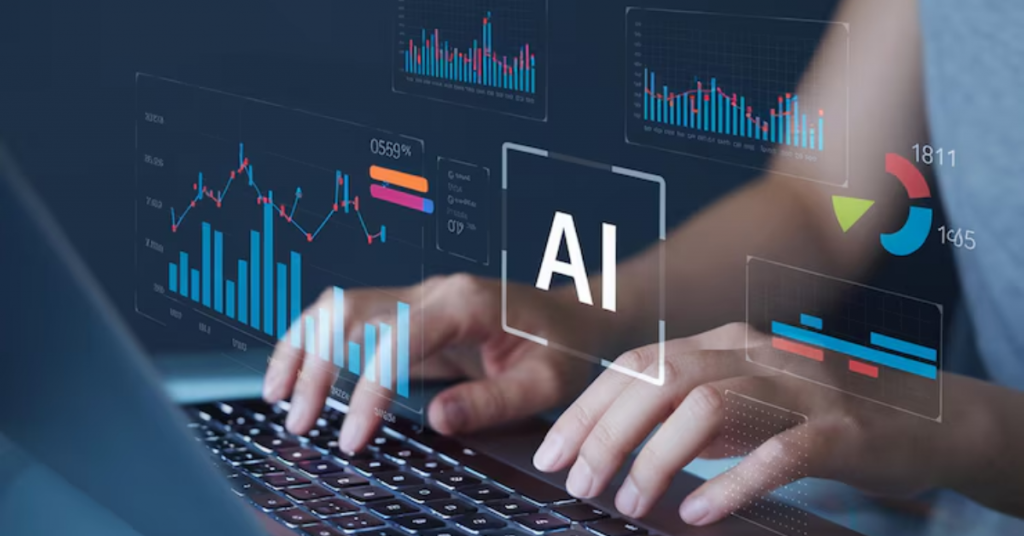
The processes in a data analysis process are likely to be the same regardless of whether a statistical approach, AI tool, or technique is employed. However, as big data becomes more common in today’s commercial environments, the utilization of AI tools becomes increasingly important.
Best practices for AI-powered data analysis include the following steps:
Step 1: Define Your Objectives
Before implementing AI in Data Analytics, it’s important to define your objectives clearly. What problem are you trying to solve? Whether you aim to predict customer churn, optimize operations, or enhance personalization, a clear goal will help you choose the right AI tools and methods.
Step 2: Choose the Right AI Tools and Platforms
Selecting the right AI tool is crucial for success. Popular AI platforms for analytics include IBM Watson, Google Cloud AI, and Microsoft Azure AI. Consider factors like ease of integration with your existing systems, scalability, and the specific AI features you need (e.g., machine learning, NLP).
Step 3: Collect and Prepare Your Data
Data preparation is the foundation of any AI model. Ensure that your data is clean, complete, and properly structured. Use AI-driven data cleansing tools to eliminate errors and inconsistencies, ensuring that the model can learn from high-quality data.
Step 4: Apply AI Models
Once the data is ready, you can start training your AI models. Whether you are building a predictive model or a classification system, the model must be trained on historical data and evaluated for accuracy. It’s important to test multiple models and algorithms to determine the best fit for your needs.
Step 5: Interpret Results and Generate Insights
Once the model generates predictions or analyses, it’s time to interpret the results. AI tools often come with visualizations to help you make sense of the findings. Use these insights to inform your decision-making processes.
Step 6: Monitor and Improve Model Performance
AI models require continuous monitoring to ensure they remain accurate over time. As new data is collected, retrain the models to incorporate fresh insights and improve their performance. Regularly check for biases and make adjustments as needed.
Future Trends in AI for Data Analytics
AI and data analytics are inextricably linked, and the Future of AI in data analytics will most certainly be marked by increased integration. AI will play an increasingly crucial role in data analysis, from identifying trends to providing insights from big datasets.
In the future of AI in data analytics we should anticipate additional advancements in automated report generation, as well as increased usage of NLP to enable natural language prompts to improve data accessibility and understandability.
Furthermore, as firms keep more personal data, AI will become a more powerful force in data security. AI tools can detect unusual behavior or patterns that may signal harmful activity, thereby protecting user data from attackers.
1. Automated Data Storytelling
AI is revolutionizing how insights are communicated through automated data storytelling. Instead of static dashboards, AI tools can now generate dynamic, narrative-driven explanations of data trends, tailored for different stakeholders. For example, a sales manager might receive a summary explaining the key drivers behind monthly performance, while an executive might get a high-level trend overview. This improves data literacy and ensures faster, more actionable decisions.
2. Conversational Analytics with AI Chatbots
AI-powered chatbots are transforming the way users interact with data. Conversational analytics enables users to ask questions in natural language (e.g., “What was our revenue last quarter?”) and receive instant, accurate responses. This eliminates the need for technical knowledge and makes data analytics more accessible to non-specialists across departments.
3. Advanced Simulations for Scenario Planning
Machine learning and AI are making scenario planning more dynamic. Businesses can now run advanced simulations to test different strategies and forecast outcomes under various hypothetical conditions. For instance, a company could simulate how a 10% increase in marketing budget might affect customer acquisition or how supply chain disruptions could impact delivery timelines.
4. Real-Time Problem Detection and Alerts
One of AI’s strongest role of AI in data analysis is real-time monitoring. AI algorithms can continuously scan data streams to detect anomalies or emerging issues. This proactive approach allows companies to respond to problems—like equipment failures, fraud attempts, or customer service bottlenecks—before they escalate.
5. Embedded AI Within Business Applications
Rather than being standalone tools, AI features are increasingly embedded into everyday business applications like CRMs, ERPs, and HR systems. This tight integration allows users to leverage AI insights within their existing workflows, reducing friction and improving adoption.
6. Emergence of Prescriptive Intelligence
Beyond descriptive and predictive analytics, prescriptive intelligence is the next frontier. AI systems are beginning to not only forecast future events but also recommend optimal courses of action and execute decisions autonomously, closing the loop between data insights and strategic execution.
Why Choose A3Logics for AI in Data Analytics?
In a crowded landscape of data analytics providers, A3Logics stands out as a trusted partner offering cutting-edge data analytics services tailored to your business needs.
> Overview of A3Logics Expertise
A3Logics has extensive experience in implementing AI-driven data analytics solutions across industries such as healthcare, retail, finance, logistics, and education. With a dedicated team of data scientists, AI engineers, and domain experts, the company ensures that each solution is designed to deliver measurable business outcomes.
> Key Services Offered in AI and Analytics
- End-to-End Data Analytics Services: From strategy and consultation to implementation and support.
- AI Model Development: Custom machine learning and deep learning models tailored to business use cases.
- Data Engineering: Scalable data pipelines and ETL processes to ensure high-quality data input.
- Real-Time Analytics: Live data streaming and dashboarding for immediate decision-making.
- Predictive and Prescriptive Analytics: Advanced modeling to guide strategy and resource allocation.
- Data Visualization: Interactive dashboards and storytelling tools for intuitive insights.
With A3Logics, organizations don’t just get analytics—they get an intelligent system that evolves with their data and business environment.

Conclusion
AI in data analytics is not just a trend—it’s a transformation. From faster data processing to smarter insights, AI is reshaping how organizations approach data-driven decision-making. Businesses that embrace AI-powered analytics today will be better positioned to navigate tomorrow’s challenges with confidence and clarity.
However, the successful use of Artificial Intelligence in Data Analytics requires more than just technology. It demands strategic alignment, high-quality data, skilled personnel, and the right partners.
A3Logics offers the expertise, tools, and support you need to implement and scale AI in your analytics initiatives effectively. Whether you’re just starting out or looking to optimize an existing system, A3Logics helps you harness the full potential of AI to drive smarter outcomes.
Ready to future-proof your data analytics with AI?



